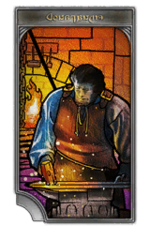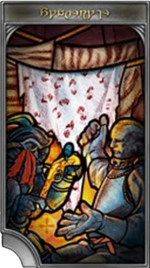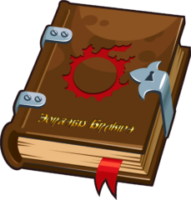Tome Request – Mimiru Mimiruki
Tome Retrieved – ‘On The Twelve and their Aspects – Rhalgr, the Mage of Levin’ by Archon Niniri Niri

Rhalgr is famed as the Breaker of Worlds, who watches over the world as a mage who carries a mighty bronze staff. His symbol, a Meteor, speaks to his reputation as a deity of destructivity. Rhalgr is the patron of Ala Mhigo and his association with the city-state dates back to the refugees who settled in Gyr Abania during the Sixth Umbral Calamity. Rhalgr must have been the patron deity of another city-state during the Fifth Astral Era, though the identity of this state is unclear at current. He is commonly considered a deity of lightning. In the theology of the Twelve, Rhalgr is regarded as the father of Byregot and Halone. He is also commonly associated with Nymeia as her attendant. Rhalgr is represented in the Major Arcana by the Spire, and by the suit of Crowns in the Deck of Sixty. He is regarded as as representing the eighth moon of the Eorzean Calendar. Rhalgr is often believed to be represented amongst the religions of Eorzea’s beastfolk, namely the sylphs and their deity Ramuh, due to the two both being mages who wield staves and are associated with lightning.
Rhalgr’s role in Lewphon’s definitive Tale of Creation – Rhalgr emerges in the tale of Creation as one of the younger gods of the Twelve, created by Nymeia out of a speeding comet. Nymeia was in despair of her children’s chaotic influence on the world, and so she brought a meteor down to the ground that it might destroy in part the rising mountains of Oschon, the swelling seas of Llymlaen and the flowing rivers of Thaliak, granting the world a measure of order. This meteor was Rhalgr, the Destroyer, who then reigned for eons alongside his fellow gods in a time of harmony.
One day however, the primordial essence of creation known as the Whorl awoke, spawning two new gods, Halone and Byregot. Nymeia saw the danger in the ambition of these young gods, and in order to check the chaos they might spawn she entrusted the to her servant Rhalgr as children. Byregot immediately did not get on with Rhalgr, as he was a builder where Rhalgr only destroyed, and so he went on to apprentice himself to Thaliak. Halone and her father were closer, however, and the two spent a great deal of time together, with Halone learning much from his teachings.
The Hell and Heaven of Lightning – Rhalgr’s lightning is the substance that powers the immense mechanical tower of Byregot’s artifice that comprises the Heaven of Lightning. Engineers and architects reside here, embodying the craft of Byregot, while revolutionaries and conquerors who did not become tyrants reside there in their afterlives as reflections of Rhalgr’s power. The tower discharges bolts of levin and fragments of the comet that the tower was wrought from fall into the pit that is the Hell of Lightning, where they injure and pain those who in life were vandals and slumlords, profaning Byregot’s edifices, and the evil warmongers, who profaned the holy was of Rhalgr.

Father of the Gryphons – The tale of Rhalgr leading the refugees fleeing the Calamity of Water into Gyr Abania’s highlands with a comet is as famous as any in Eorzea. The refugees’ gratitude for this act of service ensured that Rhalgr would go on to become the patron god of the region. The region would not be united into a single state for over a millennium however, remaining a disparate group of warring clans until Anshelm Cotter united them in the year of 1135. This led to Rhalgr’s faith splintering in turn, although one was, is and always has been larger than its peers. This is the Fist of Rhalgr, a sect devoted to eternal struggle to survive and the honing of one’s physicality, attractive to the Gyr Abanians due to the brutality of their homeland’s terrain and fauna. In combination with the warlike clan culture of Gyr Abania’s first milennium of history this ensured that Ala Mhigo would mature into a warlike state.
By the time that Ala Mhigo had unified the Fist of Rhalgr was an immensely powerful organisation in both the religious, secular and military worlds of the state due to their popularity and the large army of warrior-monks their order boasted. Thus they were folded into the state as its official protectors and as well as its official religion. Despite their power, dark days were ahead for the Fist as the mad king of Ala Mhigo, Theodoric, declared the official religion of Ala Mhigo to be the worship of Nymeia, hoping to use her superiority over Rhalgr in religious doctrine to seize further control of the county.
When the elders of the Fist refused to venerate Theodoric as a god-king under Nymeia, he had them captured immediately, torturing and murdering them and then declaring a purge of the Fist of Rhalgr. In the year 1552 Theodoric’s followers took the Temple of the Fist, razing it to the ground and butchering many of the remaining monks. Fortunately some survived, and after the liberation of Ala Mhigo the order is being rebuilt as a core of the new state.

The Saints of the Destroyer – Rhalgr boasts a number of saints validated by the Council of Loetstym, a formalized process initiated by the Archon Loetstym Merlzirnsyn five hundred years ago that standardized canonization of saints of the Twelve and has met every seven years since in old Sharlayan. Moergynn was a Roegadyn smith of considerable skill who was approached by two noble-born brothers who had quarreled and sought armaments for a duel. He accepted their commissions, forging them a pair of blades and making alterations for them as they stopped by with additional instructions. Moergynn took each instruction and carried them out completely, and when the time came for the duel he presented the two brothers their blades. To their astonishment the blades were edgeless, and Moergynn revealed that he had merely followed their instructions, resulting in the edgeless, misshapen creations without any care for his reputation. His faithful adherence earned him elevation as a saint of constancy.

Wargbhar, the Truthful Bear, was a pioneer famed for his mirthfulness and good will, which he extended to all those who he met regardless of their race or origin. He founded a settlement, and it became a place in which diverse peoples could come to live together and face threats as one. Wargbhar’s positive regard extended even to the beast tribes, and he became a prominent trader with their ranks. His kindness saw him elevated as a saint of sincerity.
Real World Basis – Rhalgr is likely based in part on Zeus, the famous lightning bolt-slinging patron god of Greek myth who is commonly depicted with a similarly bearded and elderly yet strong aspect to Rhalgr. Similarly, Rhalgr may represent in part Indra, the wind and storm god of Hinduism, and Hinduism is certainly an influence on aspects of Gyr Abania.




Leave a Reply